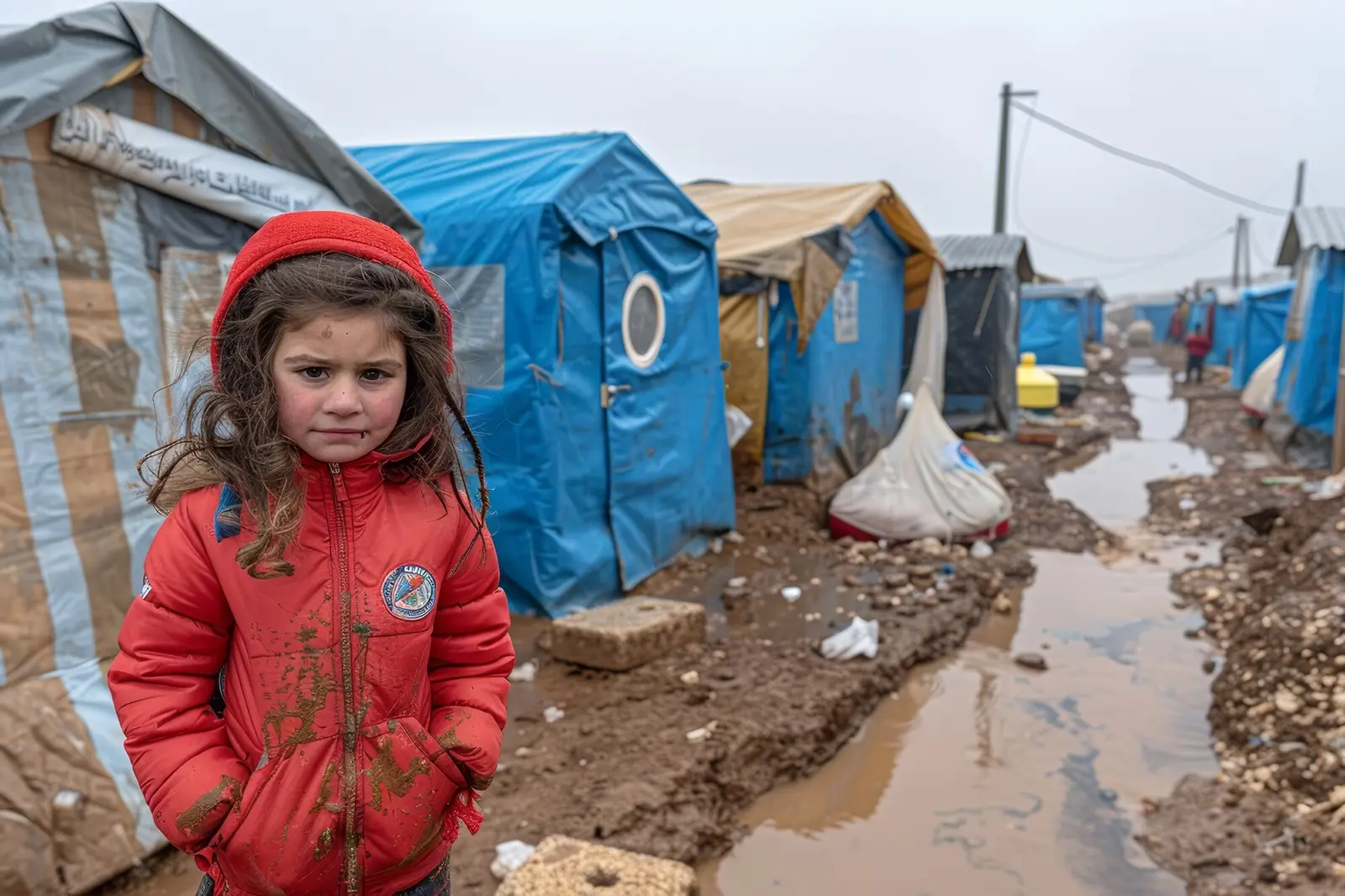
Areeba Iqbal Qureshi
Areeba Iqbal Qureshi is a final-year law student at Ziauddin University, Karachi, with a strong interest in international law, climate justice, and human rights.
Introduction
One of the key factors accelerating other drivers of forced displacement is climate change. Referred to as ‘legally void’ by United Nations (U.N) Secretary-General António Guterres, climate refugees face an uncertain future. These individuals are forced to leave their homes due to climate disasters and the escalating effects of climate change. As a result of the worsening climate change, South Asia is regarded as one of the vulnerable regions that suffer the wrath of climate change and human-induced disasters. People who are already struggling to make ends meet are compelled to move to safer areas, leaving many of them homeless. According to the Global Report on Internal Displacement (IDMC 2022), floods, droughts, and cyclones that were particularly severe in South Asia led to a higher number of displacements. Moreover, research by Sign et al. (2020)1, Climate Action Network South Asia, and ActionAid International have stated that due to climatic conditions and worsening disasters, by 2050, climate refugees will be more than 62.9 million in South Asia2.
The Vulnerable Countries of South Asia
The most vulnerable populations those from marginalised communities, those with low skills and literacy levels, and those living in low-lying cities are those who suffer the greatest effects. Living conditions are difficult in communities near coastlines and in high-water zones, such as active flood plains, as these areas continue to be severely affected by extreme weather patterns that have an adverse effect on agriculture, livestock, and homes and, ultimately, their ability to support themselves. Communities are then forced to relocate to better locations where they can live in safety. For example, as stated by Rigaud et al. (2018), the out-migration hotspots in South Asia include eastern and northeastern Bangladesh, while migration hotspots are likely to western Bangladesh, some areas in Nepal, and southern Indian highlands3.
Political disagreements over the Paris Agreement’s goal of keeping global temperatures below 2°C will eventually result in more climate migrants. Pakistan, India, Bangladesh, Sri Lanka, and Nepal are South Asian nations that will be especially severely hit. Similar to when people are forced to leave their homes during war or forced to migrate4.
One such instance is Cyclone Amphan, which struck Bangladesh and India in May 2020 and was one of the strongest storms to hit the region in decades. In addition to displacing a large number of people in Bangladesh, India, and Sri Lanka, it destroyed over a million houses that were not disaster-proof. Cyclone Amphan was one instance of climate-related migration; other examples include other South Asian countries; for example, climate change is a significant driver of displacement in Afghanistan, as highlighted by the Humanitarian Response Plan (HRP)5. It has severely impacted agriculture, leading to food insecurity and triggering migration to neighbouring provinces or countries such as Iran and Pakistan. The case of Afghanistan provides notable examples of how climate change amplifies existing vulnerabilities, driving both cross-border and internal migration. It must be highlighted that Afghanistan ranked sixth on the Global Climate Risk Index in 2019. Even before the U.S. withdrawal and Taliban takeover, environmental policy was neglected. This later contributed to half of the country facing severe food shortages, largely due to extreme climatic conditions such as flash floods and droughts during May 2022. These disasters wreak havoc on agro-based countries where communities largely depend on agriculture, forcing them to leave their homes. Interstate migration has been witnessed due to worsening climatic conditions; Afghans with families migrated to neighboring countries, mainly Pakistan and Iran. Often without legal status, they later suffered from limited rights and low living standards. It is reported that in 2018, environmental disasters displaced a thousand refugees into neighboring countries, where they faced further challenges in settling, and many were later returned6. Last but not least, in 2022, Pakistan experienced devastating floods that affected approximately 33 million people, claimed over 1,700 lives, and forcibly displaced nearly 7 million individuals. This shows how a changing climate affects people’s ability to remain in one area of the country and forces them to migrate to another province or country7.
Climate Refugees of Maldives
A prime example of ‘climate refugees’ is the Maldives, an island nation in South Asia and a popular tourist destination that is predicted to disappear in coming years due to rising sea levels. This implies that the island, whose economy is mainly based on fishing and tourism, will probably become uninhabitable, hence, increasing the number of climate refugees. Maldivians will be forced to relocate due to the rising sea levels, which will likely cause 1200 of the country’s islands to become submerged in the ocean. Even though the Maldives’ leaders worked together with countries such as Australia, India, and Sri Lanka to decide on an evacuation plan when Maldives become inhabitable8, but the problem remains as the ‘climate refugees’ are not yet defined meaning they will not be granted refugee status hence making it tougher to find a better livelihood in the future. This lack of recognition also means that the displaced Maldivians will face logistical support such as resettlement support in other areas, lack of legal protection, and profound cultural and social concerns which will eventually lead to loss of cultural identity. Furthermore, settling in new social settings will cause them to lose their Maldivian Heritage, forcing them to adapt to new languages, become familiar with unfamiliar local customs, and struggle to secure better jobs or education.
Despite the threat of being swallowed by the ocean, Maldives leaders continue to work for their citizens, ensuring they are protected with the rights and protections they deserve once they are relocated due to the future inhabitability of the Maldives. To help them further, they work around mitigation plans, adaptation and collect funds for the people being displaced due to climate change9.
Defining Climate Refugees
It must be noted, the people displaced due to climate change are known to be climate migrants, while the phenomenon of ‘climate refugees’ has been present in public discourse since 1985 when the ‘environmental refugees’ were defined by Essam El Hinnawi UN Environmental Programme Expert. Even though the practical difference between ‘climate’ and ‘environmental’ remains unclear but still same definition is used for climate refugees which states, ‘…those people who have been forced to leave their traditional habitat, temporarily or permanently, because of marked environmental disruption (natural and/or triggered by people) that jeopardized their existence and/or seriously affected the quality of their life’. 10
The 1951 Convention and its 1967 Protocol are the only binding legal treaties defining refugees, their rights, and nations’ obligations to protect them. While the 1951 Convention defines refugees as people who are fleeing their country of origin due to various factors, excluding ‘climate refugees,’ and they remain unprotected within legal frameworks, being overlooked in the global migration discussions to be fairly called ‘the forgotten ones’. Although the Paris Agreement under the United Nations Framework Convention on Climate Change (UNFCCC) recognizes the connection between human mobility and climate change and established the Task Force on Displacement under the Warsaw International Mechanism for Loss and Damage to advise on managing climate-induced displacement, the agreement itself still lacks binding enforcement power11. The non-binding nature of the Paris Agreement increases the limitations on legal protection and proper funding, as international donors are often hesitant to support large-scale funding12 without binding legal obligations and due to political sensitivities. In addition, even if domestic solutions were implemented successfully, international corporations are still crucial to protect the people displaced in the context of climate change and human-induced disasters.
Therefore, a key success could be the Model International Mobility Convention (MIMC)13 drafted by various academics and policy experts- if it becomes binding if adopted by member states of an international organisation like the U.N and might fill the void in which climate refugees exist. This way, global corporations will lend a hand to the developing climate migration crisis.
Conclusion
Recognizing climate refugees as a legal category is no longer a choice but a necessity. As climate disasters intensify, millions in South Asia face displacement without protection. It is recommended that ‘climate refugees’ be recognised globally in the same way that ‘environmental refugees’ are, in order to give people or communities who are relocated or are forcibly displaced due to climatic conditions or inhabitability in the region are given the rights to rebuild their lives for a better future and not struggle to sustain a simple life such as people of Maldives. Also, legal protections for climate-induced migrations remain limited, particularly across borders. The Kampala Convention is one of the few binding instruments recognizing intra-state climate displacement, requiring African Union members to prevent and manage such crises. However, it does not apply to inter-state migration, leaving a major gap. In the Pacific, New Zealand for example has PAC Scheme that provides limited migration pathways for citizens from climate-vulnerable nations like Kiribati and Tuvalu, but is too narrow in scope and lacks an explicit climate basis. Kiribati’s ‘Migration with Dignity’ initiative also offers a proactive, skills-based migration model, yet depends on host countries’ cooperation. This raises human rights concerns, as climate impacts increasingly threaten the right to life and adequate living standards, especially in the Global South. Urgent global coordination is needed to address both legal and humanitarian gaps14. Furthermore, broadening the definition of refugees in the 1951 Convention and amending it to include climate refugees would provide uniform terminology and a much-needed legal framework to protect them. Climate migration isn’t just an environmental issue; it’s a human rights crisis that demands immediate policy action.
- Pritha Datta, Protecting victims of climate-induced migration and displacement in South Asia 2022 ↩︎
- Climate migration in South Asia set to tremble by 2050 due to political inaction on global warming 2020 ↩︎
- Pritha Datta, Protecting victims of climate-induced migration and displacement in South Asia 2022 ↩︎
- Climate migration in South Asia set to tremble by 2050 due to political inaction on global warming 2020 ↩︎
- Noori & Author details Sameera Noori, Climate change, conflict and displacement: perspectives from Afghanistan ↩︎
- Nasrat Sayed and Said Hashmat Sadat, Climate Change Compounds Longstanding Displacement in Afghanistan ↩︎
- Climate-induced displacement: South Asia’s clear and present danger ↩︎
- Environmental refugee ↩︎
- Team, How the Maldives struggles to stay afloat due to climate change 2022 ↩︎
- European Parliament ↩︎
- Megan Scopp, LLM, Climate-Induced Displacement: Establishing Legal Protections for Climate Refugees ↩︎
- Lawrence Huang, Why Financing Responses to Climate Migration Remains a Challenge ↩︎
- Caitlan M. Sussman, A Global Migration Framework Under Water: How Can the International Community Protect Climate Refugees? ↩︎
- Megan Scopp, LLM, Climate-Induced Displacement: Establishing Legal Protections for Climate Refugees ↩︎
Bibliography
European Parliament. https://www.europarl.europa.eu/RegData/etudes/BRIE/2021/698753/EPRS_BRI(2021)698753_EN.pdf
2020, 18 December (2020a) Climate migration in South Asia set to treble by 2050 due to political inaction on global warming, ActionAid International. Available at: https://actionaid.org/news/2020/climate-migration-south-asia-set-treble-2050-due-political-inaction-global-warming
Climate-induced displacement: South Asia’s clear and present danger Wilson Center. Available at: https://www.wilsoncenter.org/article/climate-induced-displacement-south-asias-clear-and-present-danger
Environmental refugee Education. Available at: https://education.nationalgeographic.org/resource/environmental-refugee/
Pritha Datta, B.B. (2022a) Protecting victims of climate-induced migration and displacement in South Asia, Asia Pathways. Available at: https://www.asiapathways-adbi.org/2022/06/protecting-victims-of-climate-induced-migration-and-displacement-in-south-asia/
Team, C. (2022) How the Maldives struggles to stay afloat due to climate change, CATALYST. Available at: https://catalyst.cm/stories-new/2022/12/9/how-the-maldives-struggles-to-stay-afloat-due-to-climate-change#:~:text=A%20recent%20report%20said%20that,displaced%20and%20become%20climate%20refugees.
The Missing Refuge for “Climate Refugees” in the International Legal Framework: A Dialogue with Caitlan M. Sussman https://gjia.georgetown.edu/2024/09/21/the-missing-refuge-for-climate-refugees-in-the-international-legal-framework-a-dialogue-with-caitlan-m-sussman/
Karachi expected to receive 2.3 million climate migrants by 2050: Report: https://news.mongabay.com/short-article/karachi-expected-to-receive-2-3-million-climate-migrants-by-2050-report/#:~:text=A%20new%20study%20finds%20that,collective%20impact%20on%20the%20city.
A Global Migration Framework Under Water: How Can the International Community Protect Climate Refugees? By: Caitlan M. Sussman https://cjil.uchicago.edu/online-archive/global-migration-framework-under-water-how-can-international-community-protect
Climate change, conflict and displacement: perspectives from Afghanistan By Noori & Author details Sameera Noori https://odihpn.org/publication/climate-change-conflict-and-displacement-perspectives-from-afghanistan/#:~:text=Climate%20change%2C%20a%20significant%20driver,have%20home%20or%20land%20there.
Climate Change Compounds Longstanding Displacement in Afghanistan By Nasrat Sayed and Said Hashmat Sadat https://www.migrationpolicy.org/article/climate-change-displacement-afghanistan?utm_source=chatgpt.com
Why Financing Responses to Climate Migration Remains a Challenge By Lawrence Huang https://www.migrationpolicy.org/news/limited-climate-financing-responses-climate-migration?utm_source=chatgpt.com
Climate-Induced Displacement: Establishing Legal Protections for Climate Refugees by Megan Scopp, LLM https://www.humanrightsresearch.org/post/climate-induced-displacement-establishing-legal-protections-for-climate-refugees?utm_source=chatgpt.com

Areeba Iqbal Qureshi
Areeba Iqbal Qureshi is a final-year law student at Ziauddin University, Karachi, with a strong interest in international law, climate justice, and human rights.
“These views belong to the author and do not reflect the views of the Policy Research Institute for South Asia (PRISA) or its team.”
Table of Contents
Toggle

